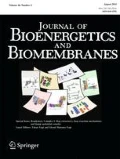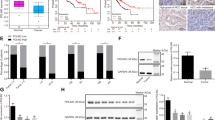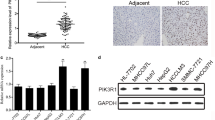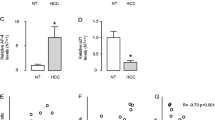Abstract
Phosphatidylinositol 4-phosphate adaptor protein 2 (FAPP2) has been recently identified as a tumor-associated regulator that is closely related to tumorigenesis. Yet, the precise role of FAPP2 in hepatocellular carcinoma (HCC) is still largely unknown. This study was designed to determine the function and molecular mechanisms of FAPP2 in HCC. Elevated expression of FAPP2 commonly occurred in the tumor tissue of HCC compared with normal controls. High expression of FAPP2 was also detected in HCC cell lines and its knockdown markedly decreased the proliferation, colony formation and invasion of HCC cells. Upregulation of FAPP2 by using a FAPP2 expression vector markedly promoted the proliferation, colony formation and invasion of HCC cells. FAPP2 was found to promote the activation of Wnt/β-catenin signaling. Importantly, inhibition of Wnt/β-catenin signaling abrogated the FAPP2 overexpression-conferred oncogenic effect in HCC cells. In addition, xenograft tumor experiments revealed that knockdown of FAPP2 significantly decreased the tumorigenicity of HCC cells in vivo. Taken together, the data of our study reported a tumor-promotion function of FAPP2 in HCC and demonstrate that knockdown of FAPP2 was capable of suppressing HCC cell proliferation and invasion through downregulation of Wnt/β-catenin signaling. This study indicated that FAPP2 might be an attractive candidate anticancer target for HCC.






Similar content being viewed by others
Data availability
The data and material used to support the findings of this study are available from the corresponding author upon request.
References
Anastas JN, Moon RT (2013) WNT signalling pathways as therapeutic targets in cancer. Nat Rev Cancer 13:11–26
Bray F, Ferlay J, Soerjomataram I, Siegel RL, Torre LA, Jemal A (2018) Global cancer statistics 2018: GLOBOCAN estimates of incidence and mortality worldwide for 36 cancers in 185 countries. CA Cancer J Clin 68:394–424
Cao X, Coskun U, Rossle M, Buschhorn SB, Grzybek M, Dafforn TR, Lenoir M, Overduin M, Simons K (2009) Golgi protein FAPP2 tubulates membranes. Proc Natl Acad Sci U S A 106:21121–21125
Chalat M, Menon I, Turan Z, Menon AK (2012) Reconstitution of glucosylceramide flip-flop across endoplasmic reticulum: implications for mechanism of glycosphingolipid biosynthesis. J Biol Chem 287:15523–15532
Chen J, Li L, Zhou Z, Yu S, Li Y, Gao Y (2019) FAPP2 promotes tumor cell growth in human colon cancer through activation of Wnt signaling. Exp Cell Res 374:12–18
Clevers H (2006) Wnt/beta-catenin signaling in development and disease. Cell 127:469–480
Cui Y, Wu X, Lin C, Zhang X, Ye L, Ren L, Chen M, Yang M, Li Y, Li M, Li J, Guan J, Song L (2019) AKIP1 promotes early recurrence of hepatocellular carcinoma through activating the Wnt/beta-catenin/CBP signaling pathway. Oncogene 38:5516–5529
D'Angelo G, Polishchuk E, Di Tullio G, Santoro M, Di Campli A, Godi A, West G, Bielawski J, Chuang CC, van der Spoel AC, Platt FM, Hannun YA, Polishchuk R, Mattjus P, De Matteis MA (2007) Glycosphingolipid synthesis requires FAPP2 transfer of glucosylceramide. Nature 449:62–67
D'Angelo G, Rega LR, De Matteis MA (2012) Connecting vesicular transport with lipid synthesis: FAPP2. Biochim Biophys Acta 1821:1089–1095
Eldai H, Periyasamy S, Al Qarni S, Al Rodayyan M, Muhammed Mustafa S, Deeb A, Al Sheikh E, Afzal M, Johani M, Yousef Z, Aziz MA (2013) Novel genes associated with colorectal cancer are revealed by high resolution cytogenetic analysis in a patient specific manner. PLoS One 8:e76251
Fan W, Du F, Liu X (2019) TRIM66 confers tumorigenicity of hepatocellular carcinoma cells by regulating GSK-3β-dependent Wnt/beta-catenin signaling. Eur J Pharmacol 850:109–117
Ferlay J, Colombet M, Soerjomataram I, Mathers C, Parkin DM, Pineros M, Znaor A, Bray F (2019) Estimating the global cancer incidence and mortality in 2018: GLOBOCAN sources and methods. Int J Cancer 144:1941–1953
Godi A, Di Campli A, Konstantakopoulos A, Di Tullio G, Alessi DR, Kular GS, Daniele T, Marra P, Lucocq JM, De Matteis MA (2004) FAPPs control Golgi-to-cell-surface membrane traffic by binding to ARF and PtdIns(4)P. Nat Cell Biol 6:393–404
Halter D, Neumann S, van Dijk SM, Wolthoorn J, de Maziere AM, Vieira OV, Mattjus P, Klumperman J, van Meer G, Sprong H (2007) Pre- and post-Golgi translocation of glucosylceramide in glycosphingolipid synthesis. J Cell Biol 179:101–115
Islami F, Goding Sauer A, Miller KD, Siegel RL, Fedewa SA, Jacobs EJ, McCullough ML, Patel AV, Ma J, Soerjomataram I, Flanders WD, Brawley OW, Gapstur SM, Jemal A (2018) Proportion and number of cancer cases and deaths attributable to potentially modifiable risk factors in the United States. CA Cancer J Clin 68:31–54
Liang Y, Feng Y, Zong M, Wei XF, Lee J, Li H, Yang GS, Wu ZJ, Fu XD, Feng GS (2018) Beta-catenin deficiency in hepatocytes aggravates hepatocarcinogenesis driven by oncogenic beta-catenin and MET. Hepatology 67:1807–1822
Reya T, Clevers H (2005) Wnt signalling in stem cells and cancer. Nature 434:843–850
Shi J, Zheng H, Yuan L (2019) High NDRG3 expression facilitates HCC metastasis by promoting nuclear translocation of beta-catenin. BMB Rep 52:451–456
Siegel RL, Miller KD, Jemal A (2018) Cancer statistics, 2018. CA Cancer J Clin 68:7–30
Tritz R, Hickey MJ, Lin AH, Hadwiger P, Sah DW, Neuwelt EA, Mueller BM, Kruse CA (2009) FAPP2 gene downregulation increases tumor cell sensitivity to Fas-induced apoptosis. Biochem Biophys Res Commun 383:167–171
Tsao DA, Chang HJ, Lin CY, Hsiung SK, Huang SE, Ho SY, Chang MS, Chiu HH, Chen YF, Cheng TL, Shiu-Ru L (2010) Gene expression profiles for predicting the efficacy of the anticancer drug 5-fluorouracil in breast cancer. DNA Cell Biol 29:285–293
Vieira OV, Verkade P, Manninen A, Simons K (2005) FAPP2 is involved in the transport of apical cargo in polarized MDCK cells. J Cell Biol 170:521–526
Vieira OV, Gaus K, Verkade P, Fullekrug J, Vaz WL, Simons K (2006) FAPP2, cilium formation, and compartmentalization of the apical membrane in polarized Madin-Darby canine kidney (MDCK) cells. Proc Natl Acad Sci U S A 103:18556–18561
Vilchez V, Turcios L, Marti F, Gedaly R (2016) Targeting Wnt/β-catenin pathway in hepatocellular carcinoma treatment. World J Gastroenterol 22:823–832
Yamaji T, Kumagai K, Tomishige N, Hanada K (2008) Two sphingolipid transfer proteins, CERT and FAPP2: their roles in sphingolipid metabolism. IUBMB Life 60:511–518
Yui N, Okutsu R, Sohara E, Rai T, Ohta A, Noda Y, Sasaki S, Uchida S (2009) FAPP2 is required for aquaporin-2 apical sorting at trans-Golgi network in polarized MDCK cells. Am J Physiol Cell Physiol 297:C1389–C1396
Author information
Authors and Affiliations
Contributions
Wanhu Fan designed this study, performed the experiments and drafted the manuscript. Fenjing Du designed this study and revised the manuscript. Xiaojing Liu collected and analyzed the data.
Corresponding author
Ethics declarations
Conflict of interest
The authors declare no conflict of interest.
Ethics approval
The animal care and experiments were carried out followed the regulations and guidelines approved by the Experimental Animal Ethical Committee of First Affiliated Hospital of Xi’an Jiaotong University.
Consent to participate
Not applicable.
Consent for publication
All authors have approved for the publication of this paper.
Code availability
Not applicable.
Additional information
Publisher’s note
Springer Nature remains neutral with regard to jurisdictional claims in published maps and institutional affiliations.
Rights and permissions
About this article
Cite this article
Fan, W., Du, F. & Liu, X. Phosphatidylinositol 4-phosphate adaptor protein 2 accelerates the proliferation and invasion of hepatocellular carcinoma cells by enhancing Wnt/β-catenin signaling. J Bioenerg Biomembr 52, 301–309 (2020). https://doi.org/10.1007/s10863-020-09852-6
Received:
Accepted:
Published:
Issue Date:
DOI: https://doi.org/10.1007/s10863-020-09852-6




